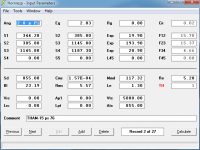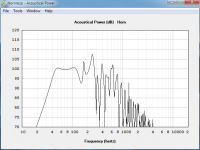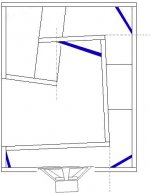I think your simulation is wrong, i have used this drivers, and this is my sims:
Your sim is missing cone correction. Vtc=5000 and Atc=855 should be in the ballpark.
Your sim is missing cone correction. Vtc=5000 and Atc=855 should be in the ballpark.
I can put that in sims, thanks for info. I practice, there is no audible peak, and woofer can go little lower than predicted.
I have stopped using this drivers, now i use drivers with 4 inch coils which i can drive with more power. Also recommend digital crossover, i use DCX2496, upgrade to this from analog crossover is very noticeable.
15 with excursion!
I just stumbled upon this high-excursion 15"
Claims 20mm excursion!
Loudspeakers 15 XW 127 Extreme :: Clear Sound
In general I don't find their specs over stated, in fact the oppposite, complete speakers look heavy to me:
Clearsound -what's the hype? The heaviest speakers - Speakerplans.com Forums - Page 1
I just stumbled upon this high-excursion 15"
Claims 20mm excursion!
Loudspeakers 15 XW 127 Extreme :: Clear Sound
In general I don't find their specs over stated, in fact the oppposite, complete speakers look heavy to me:
Clearsound -what's the hype? The heaviest speakers - Speakerplans.com Forums - Page 1
I just stumbled upon this high-excursion 15"
Claims 20mm excursion!
Loudspeakers 15 XW 127 Extreme :: Clear Sound
In general I don't find their specs over stated, in fact the oppposite, complete speakers look heavy to me:
Clearsound -what's the hype? The heaviest speakers - Speakerplans.com Forums - Page 1
Is this supposed to be a 12" driver or 15"? SD appears to be for a 12".
Is this supposed to be a 12" driver or 15"? SD appears to be for a 12".
I thought that Sd was small for a 15 too.
Weird, but click my second link, it looks like their webpage specs are quite weird in general..
Other drivers?
So I know I'm trying to revive an old thread, but I'm wondering if these cabs would work well with the Jbl 2226h low frequency transducers? I have quite a few laying around and I want to put them to use. If anyone could give some insight onto what might be a good cabinet to use these in,ant info would help! Thanks!
So I know I'm trying to revive an old thread, but I'm wondering if these cabs would work well with the Jbl 2226h low frequency transducers? I have quite a few laying around and I want to put them to use. If anyone could give some insight onto what might be a good cabinet to use these in,ant info would help! Thanks!
The standard version THAM15, the only one with propper drawings published is the one, but feel free to modify it as you see fit, there has been numreous proposals on how to improve their prefomrance, such as aperture chamfer, cone compensators, and various reflector proposals.
I have not looked into all of these myself, but scan the forums and ask around if you feel up to it, I'm sure you will find alot of inspiration out there.
Most people seem very happy leving it as it is, the most common modification is only adding a bit of depth to the box in order to fit a full front cover, this does not impact on or alter the design.
Hi Martinsson! Many thanks for all your work. I was all set to build a standard version but then noticed a few customisations people had made with handles etc. In particular I like the look of MagicJohansson's build seen earlier in this thread but I just wanted to ask, since it seems the basic measurements they used are the same as the original plans, should I be worried about the impact of the recessed handles, braces etc on the dimensions of the horn and the resultant sound?
Thanks
Hi a bit late, I modeled 2226 a while ago and it seemed to fit quite well in the tham15, I have built 4 now with the jbl2226h drivers and love them. they really pack a punch and sound good. GregSo I know I'm trying to revive an old thread, but I'm wondering if these cabs would work well with the Jbl 2226h low frequency transducers? I have quite a few laying around and I want to put them to use. If anyone could give some insight onto what might be a good cabinet to use these in,ant info would help! Thanks!
Nice to know they are compatible with what I would choose to call a very nicely balanced and common driver.
I did not want to design a cabinet that puts extreme demands on the driver, I never have, the main reason being that if it was to take off as a world wide popular DIY design there is little to no control over what drivers where going to be used with, and it should work OK regardless.
This can be seen in the rather generous S2 area (the amount of air cone side) an idea that came from Johannes Rodin, this puts less stress on the driver in general and it seems to have payed of since I have yet to hear of any design related driver failures (or any other failures for that matter) in the any of the THAM designs.
Today the 15TBX100 is a good average performance driver and there are far more extreme drivers out there, the trend seems to be going towards lower Q and higher BL, and it will only improve the performance further.
I did not want to design a cabinet that puts extreme demands on the driver, I never have, the main reason being that if it was to take off as a world wide popular DIY design there is little to no control over what drivers where going to be used with, and it should work OK regardless.
This can be seen in the rather generous S2 area (the amount of air cone side) an idea that came from Johannes Rodin, this puts less stress on the driver in general and it seems to have payed of since I have yet to hear of any design related driver failures (or any other failures for that matter) in the any of the THAM designs.
Today the 15TBX100 is a good average performance driver and there are far more extreme drivers out there, the trend seems to be going towards lower Q and higher BL, and it will only improve the performance further.
Another happy Tham15 builder. Using 15Tbx100. Used with db-mark xca and pkn xe2500
a couple of pics: imgur.com/a/iopb2
Thinking of adding some sort of grille but haven't found any good supplier nearby.
a couple of pics: imgur.com/a/iopb2
Thinking of adding some sort of grille but haven't found any good supplier nearby.
Thank you very much Anders, I am a believer. I built 1 THAM15 loaded with Celto Acoustique. That cabinet is just amazing.
Have you posted a cutlist for THAM18 anywhere?
Have you posted a cutlist for THAM18 anywhere?
Hello Mrscy
Thanks for the positive feedback on the THAM15, that goes for Cnyg as well 🙂
I have no cutlist the THAM18 available but perhaps the part dimensions shown in the drawings could help (see link below).
Martinsson's Blog -
Come to think of it, the THAM18 has not even their own topic here on DIYaudio, all the other THAMs do, hmmm... maybe I should change that.
Thanks for the positive feedback on the THAM15, that goes for Cnyg as well 🙂
I have no cutlist the THAM18 available but perhaps the part dimensions shown in the drawings could help (see link below).
Martinsson's Blog -
Come to think of it, the THAM18 has not even their own topic here on DIYaudio, all the other THAMs do, hmmm... maybe I should change that.
Martinson, I am looking at the THAM18 page and I am a little confused. There are two HR sims, one is called 3 segment. The output is different. The second (3 segment) has a much better upperband response. Can you explane a little what is different?
The 4 segment simulation, the top one, on which all the resulting graphs are based is a more correct way of simulating the folding since it takes the rather steep area increase between S3 and S4 into account.
The drawback then becomes that due to the limited amounts of segments allowed in hornresp, the last expansion is not simulated correctly (between S4 to S5) where it does not see the step and regards it as an even expansion between S4 and S5, it's not a big error and I had to choose and that seemed to be the least inaccurate way of doing it.
The 3 segment simulation at the bottom should really be taken away since it shows a overly optimistic result, the reason being that it does not see the S3-S4 expansion, instead it sees the S2 to S3 as one evenly expanding segment, which is false, this also becomes apparent in the systems volume window.
I hope this clears thins up a bit, and thanks for pointing this out, I will correct the post, emphasizing that the 3 segment simulation is not the correct way to simulate this folding.
The drawback then becomes that due to the limited amounts of segments allowed in hornresp, the last expansion is not simulated correctly (between S4 to S5) where it does not see the step and regards it as an even expansion between S4 and S5, it's not a big error and I had to choose and that seemed to be the least inaccurate way of doing it.
The 3 segment simulation at the bottom should really be taken away since it shows a overly optimistic result, the reason being that it does not see the S3-S4 expansion, instead it sees the S2 to S3 as one evenly expanding segment, which is false, this also becomes apparent in the systems volume window.
I hope this clears thins up a bit, and thanks for pointing this out, I will correct the post, emphasizing that the 3 segment simulation is not the correct way to simulate this folding.
Last edited:
I have a question on the THAM15,
1. Doesn't the woofer location obstruct the sound waves?
2. Wouldn't the cabinet play deeper and louder buy some margin if the woofer was located as depicted in the image. Cabinet would be 200mm wider resulting in width of 880mm.
<blockquote class="imgur-embed-pub" lang="en" data-id="xN2zr3z"><a href="//imgur.com/xN2zr3z">View post on imgur.com</a></blockquote><script async src="//s.imgur.com/min/embed.js" charset="utf-8"></script>
1. Doesn't the woofer location obstruct the sound waves?
2. Wouldn't the cabinet play deeper and louder buy some margin if the woofer was located as depicted in the image. Cabinet would be 200mm wider resulting in width of 880mm.
<blockquote class="imgur-embed-pub" lang="en" data-id="xN2zr3z"><a href="//imgur.com/xN2zr3z">View post on imgur.com</a></blockquote><script async src="//s.imgur.com/min/embed.js" charset="utf-8"></script>
1. Doesn't the woofer location obstruct the sound path?
2. Wouldn't the cabinet play louder if the woofer was placed out of the sound path?
Please see image:
2. Wouldn't the cabinet play louder if the woofer was placed out of the sound path?
Please see image:
An externally hosted image should be here but it was not working when we last tested it.
- Home
- Loudspeakers
- Subwoofers
- THAM15 - a compact 15" tapped horn


